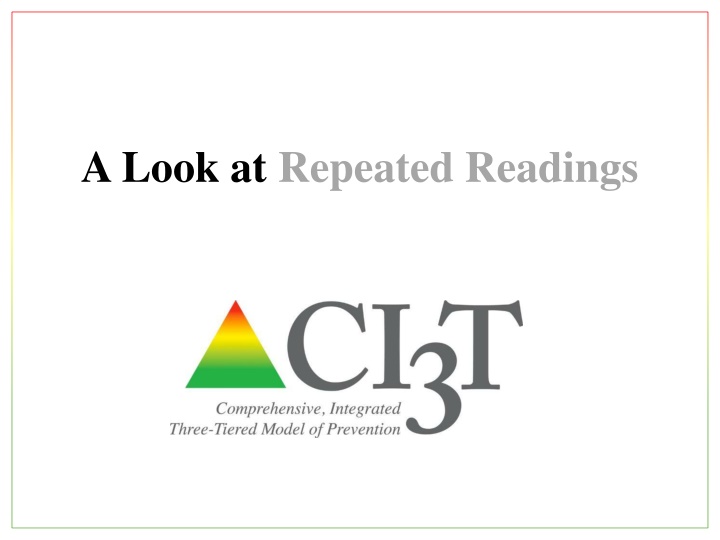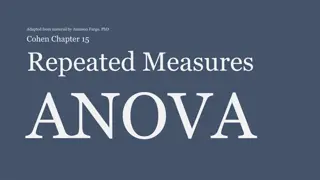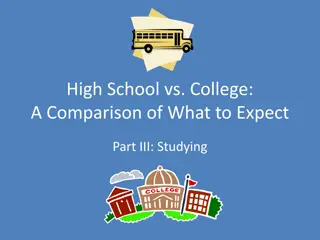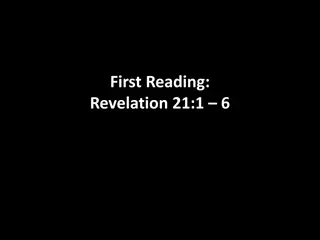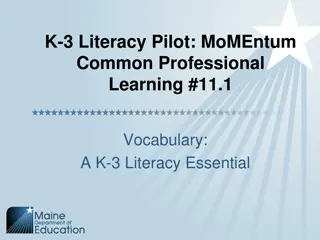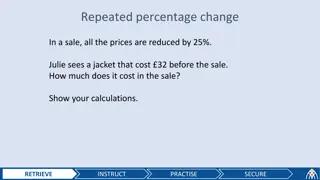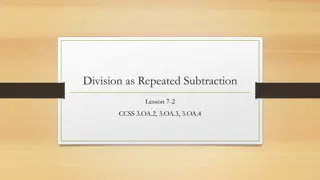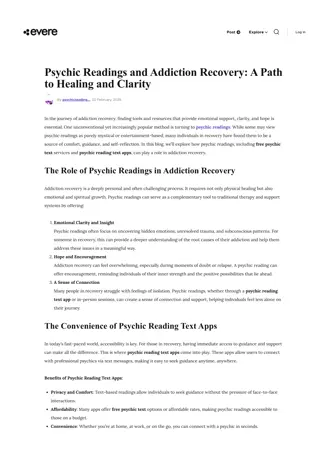A Closer Look at Repeated Readings
Repeated readings is an effective instructional strategy to enhance oral reading proficiency. Grounded in the theory of automaticity, this approach offers numerous benefits such as improved fluency and comprehension. Research supports its effectiveness for students at various grade levels. Discover how to implement repeated readings in your classroom and explore the associated benefits and challenges. Dive into the supporting research for detailed insights. Check out the Repeated Readings Resource Guide on Ci3T.org for additional information.
Download Presentation

Please find below an Image/Link to download the presentation.
The content on the website is provided AS IS for your information and personal use only. It may not be sold, licensed, or shared on other websites without obtaining consent from the author.If you encounter any issues during the download, it is possible that the publisher has removed the file from their server.
You are allowed to download the files provided on this website for personal or commercial use, subject to the condition that they are used lawfully. All files are the property of their respective owners.
The content on the website is provided AS IS for your information and personal use only. It may not be sold, licensed, or shared on other websites without obtaining consent from the author.
E N D
Presentation Transcript
Agenda What is repeated readings? Why is repeated readings effective? What does the supporting research for repeated readings say? What are the benefits and challenges? How do I implement repeated readings in my classroom? Checklist for Success How well is it working? Examining the Effects
What is repeated readings? Repeated Readings Repeated Readings is an instructional strategy used to support students in developing oral reading proficiency. Students are given multiple opportunities to practice reading aloud passages at their independent reading level, instructors provide instructive feedback after each practice opportunity (Therrien & Kubina, 2006).
Why is repeated readings effective? Repeated Readings is grounded in the theory of automaticity. The theory posits that once readers have established fluency with text at their instructional reading level, they are able to focus on comprehension (Escarpio & Barbetta, 2015; Samuels, 1979).
What does the supporting research for repeated readings say? Improved oral reading rates for elementary and middle school students (Lo, Cooke, & Starling, 2011; Oakes, Lane, & Mathur, 2010; Scott & Shearer-Lingo, 2002) Enhanced reading comprehension (WWC, 2014) Increased correct words per min read and comprehension questions answered, and generalized to novel passages for elementary students at risk for emotional and behavioral disorders (EBD; Staubitz, Cartledge, Yurick, & Lo, 2005) Improved oral reading fluency, improved comprehension, and reduced reading errors for students with EBD (Escarpio & Barbetta, 2015)
Supporting Research See Repeated Readings Resource Guide on Ci3T.org for supporting research and additional information.
What are the benefits & challenges? Benefits Cost-free Implemented with few materials and tutors can be easily trained Provides opportunities for individualized support through the use of instructive feedback Students can set goals, and graph their own progress Challenges Students may lose interest in the passage (goal setting and graphing progress supports motivation) Time for a qualified tutor to work with individual students.
How do I implement repeated readings in my classroom? Implementation Checklist ! Determine students are at the appropriate level for this intervention (see Intervention Grid). Step 1 Choose a format for implementing the intervention (e.g., small group; one-on-one with teacher, paraprofessional or peer). Step 2 Select reading passages at the independent level and collect any additional supplies (e.g., data collection sheets, timer). Step 3 Begin implementing intervention by pairing students with a qualified partner (i.e., one who can give appropriate instructive feedback). Step 4
How do I implement repeated readings in my classroom? Implementation Checklist Step 5 Set performance criterion. Student reads the passage aloud and partner provides instructive feedback (e.g., decoding. prosody, and rate). Step 6 Step 7 Graph progress. Step 8 Praise students efforts. (Therien & Kubina, 2006)
How do I implement repeated readings in my classroom? Implementation Checklist Allot time for students to read passages until they have met the performance criterion. Step 9 Implement a repeated readings routine as part of your reading instruction. Step 10 (Therien & Kubina, 2006)
How do I implement repeated readings in my classroom? Step 1: Determine students are at the appropriate level for this intervention (See Intervention Grid). Step 2: Choose a format for implementing the intervention (e.g., small group; one-on-one with teacher, paraprofessional, or peer). Step 3: Select reading passages at the independent level and collect any additional supplies (e.g., data collection sheets, timer). Step 4: Begin implementing intervention by pairing student with a qualified partner (i.e., one who can give appropriate instructive feedback). See Repeated Readings Implementation Checklist
How do I implement repeated readings in my classroom? Step 5: Set performance criterion. Step 6: Student reads the passage aloud and partner provides instructive feedback (e.g., decoding. prosody, and rate). Step 7: Graph progress. Step 8: Praise students efforts. Step 9: Allot time for students to read passages until they have met the performance criterion. Step 10: Implement a repeated reading routine as part of your reading instruction. See Repeated Readings Implementation Checklist
Repeated Reading Tools for Implementation See RR_Sample Peer Checklist
Repeated Reading Tools for Implementation See RR_Sample Teacher Data Collection Forms
Repeated Reading Tools for Implementation See RR_Sample Student Data Collection Forms
How well is it working? Examining the Effects Experimental Design Treatment Integrity Social Validity Is it What do stakeholders think about the goals, procedures, How well did this support work for happening? this and student? outcomes?
Making Certain the Strategy is in Place: Treatment Integrity See Repeated Readings Treatment Integrity Checklist
What does the student think about it? See Instructional Choice Student Social Validity Survey
What does the teacher think about it? See Social Validity Adapted-IRP15
Sample Intervention Grid Description Support School-wide Data: Entry Criteria Academic: AIMSweb Benchmark- Below Target level RCBM- Below 25% percentile Data to Monitor Progress Academic measures: - AIMSweb weekly progress monitoring RCBM. Exit Criteria Academic measures: AIMSweb progress monitoring RCBM: Reaches above targeted aim line for grade level for 3 consecutive assessment opportunities. Students engage in repeated oral reading practice (15 min, four days per week; in addition to 90 min core instruction) of appropriate text passages to build reading fluency, accuracy, and prosody.Selected passages at the student s independent reading level (at least 95% accuracy). Students are paired with a competent partner (e.g., teacher, paraprofessional, volunteer or peer). The student reads the passage, timing the reading for one min. Then the partner marks errors, insertions, and omissions on a second copy of the passage. The partner listens and provides instructive feedback. Instructive feedback is pertaining to correct decoding, words omitted during the read aloud, prosody, and words read correctly per minute. Students continue the repeated readings until a fluency goal, such as a target number of words read correctly per minute is reached or until an authentic end to the activity (e.g., presentation of Readers Theatre). Materials: Two copies of the passage (one for the student reading and another for their tutor) Graph- words read correctly per minute (WCPM) with goal marked Pencils Timer Peer Feedback Checklist Repeated Readings AIMSweb Accuracy % and WCPM: Meets criteria for Accurate and Slow Accuracy %: 2nd grade: 95% or higher 3rd-8th grade 98% or higher (Group 2 OR Grouping Worksheet) Treatment Integrity: - Implementation & Treatment Integrity Checklists - Peer feedback checklist. Continue progress monitoring until next benchmark and discontinue once student scores meet accuracy and fluency criteria (2nd grade: 95%, 3rd-8th grade: 98% or higher). Social Validity: - Teacher: Adapted IRP- 15 Tier 1: Consider authentic activities for repeated reading, such as Readers Theater.
Will you please Let s talk Continue to plan your repeated readings intervention.
